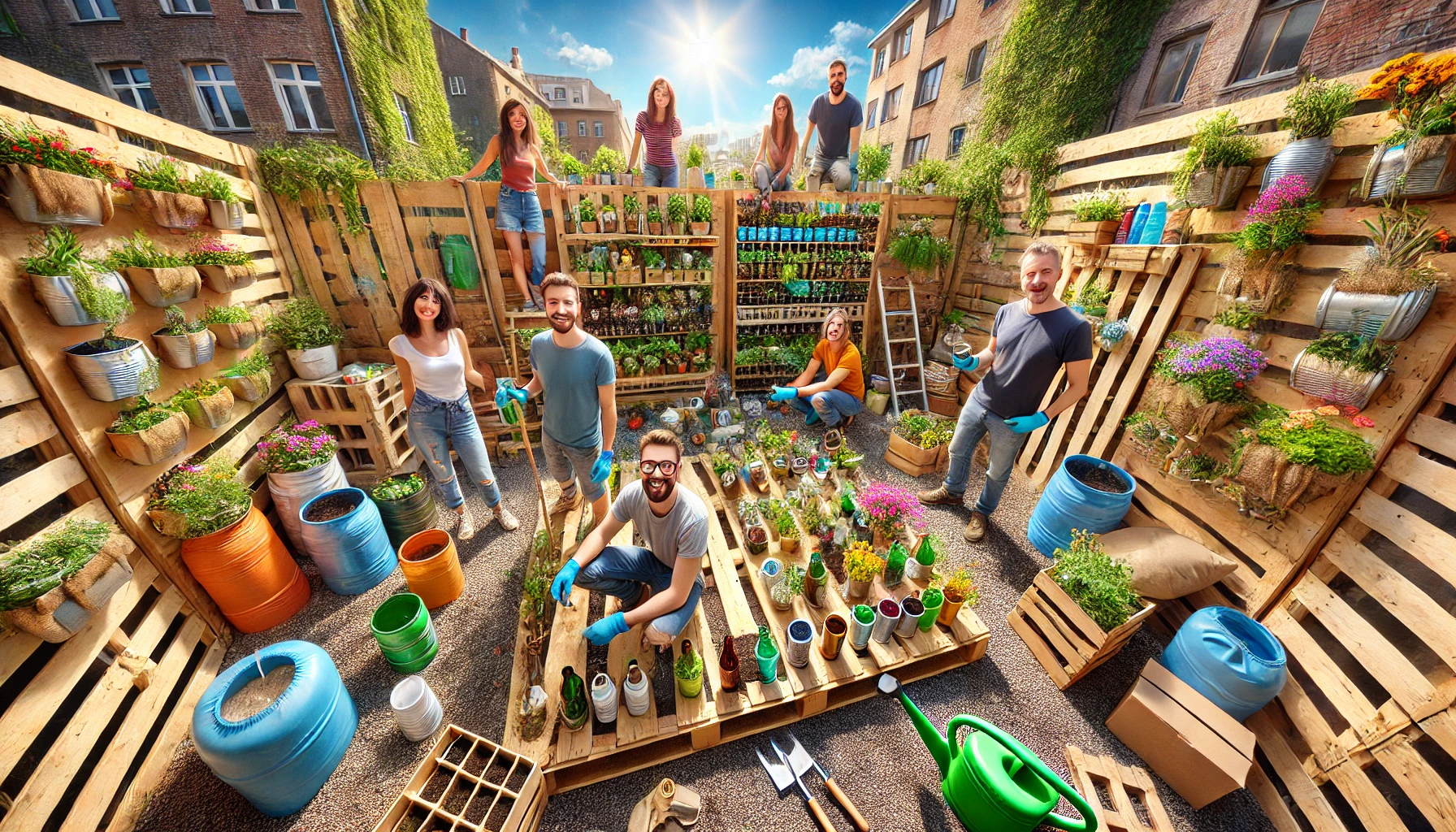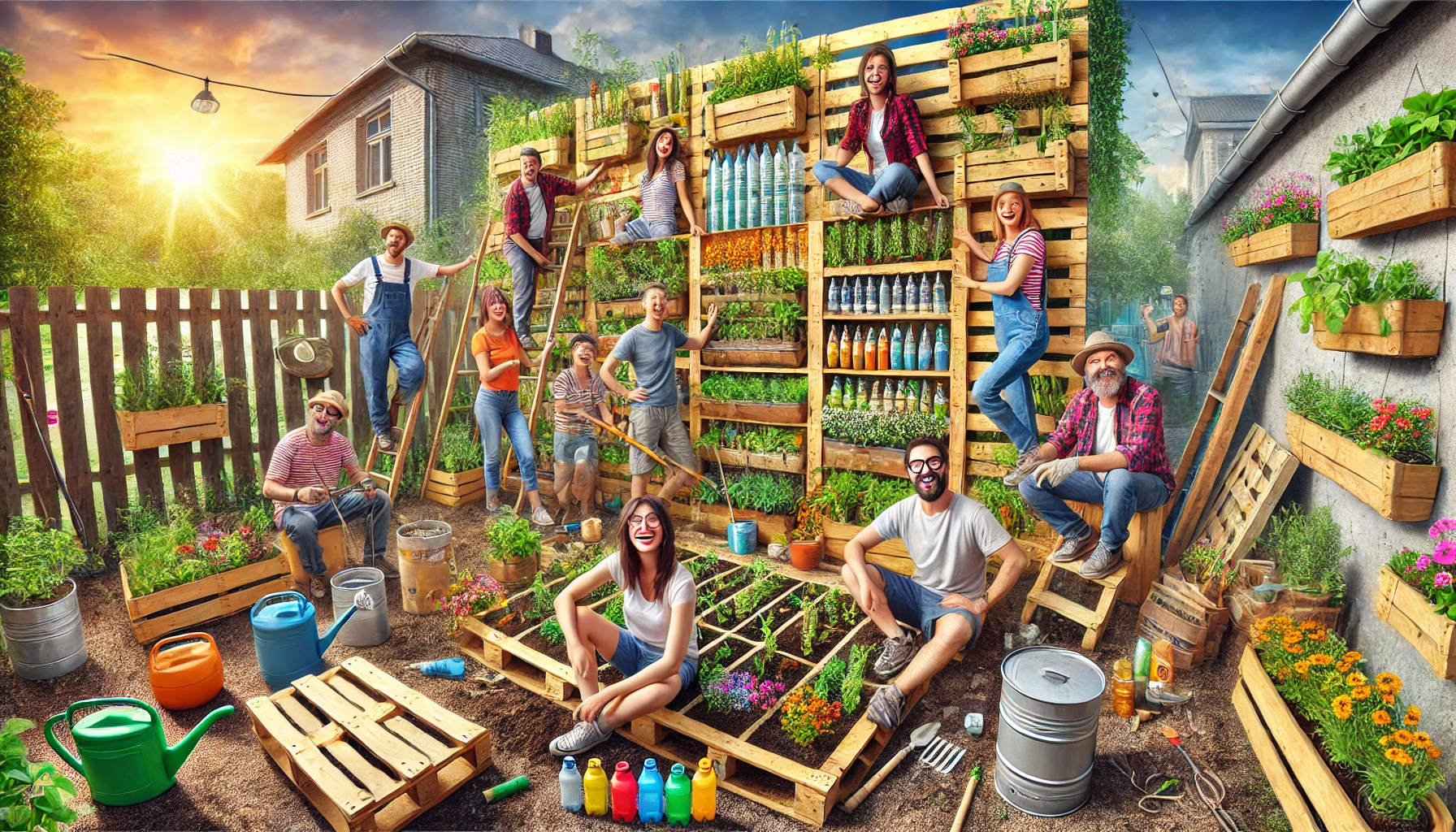Introduction to Creating a Cheap DIY Vertical Garden
A cheap DIY vertical garden is the perfect solution for anyone looking to transform their living space into a lush, green haven without spending a fortune.
Whether you’re living in a small apartment or looking to add greenery to a backyard wall, vertical gardening offers a stylish, space-saving, and cost-effective option.
This innovative gardening method not only enhances the aesthetic appeal of your home but also allows you to grow fresh herbs, vegetables, or decorative plants with minimal resources.
The appeal of vertical gardening lies in its versatility and affordability. You can achieve a functional and attractive garden space using everyday items, recycled materials, and a little creativity.
In this guide, we’ll walk you through the process of planning, building, and maintaining a vertical garden on a budget, ensuring your green thumb doesn’t break the bank.
Cost-Effective Planning for Your Vertical Garden
Why Planning Matters
Creating a vertical garden starts with thoughtful planning, especially when working on a budget. Proper planning ensures you use your resources wisely, avoid unnecessary expenses, and create a garden tailored to your space and needs. A well-thought-out plan can turn even the smallest corner into a thriving garden oasis.
Strategies for Sourcing Materials Affordably
- Shop Smart: Look for sales or discounts at local garden centers, thrift stores, or dollar stores.
- Reuse and Repurpose: Use materials you already have at home, such as old shelves, shoe organizers, or wooden crates, to create garden structures.
- Community Resources: Join local gardening groups or online communities where members often share or exchange free materials and plants.
Recycling and Repurposing Ideas
- Use old pallets as a base for a vertical garden.
- Repurpose tin cans, mason jars, or plastic bottles into plant holders.
- Transform an old ladder into a tiered garden stand.
With these strategies, you can significantly reduce costs while giving your garden a unique, personal touch.
Materials & Tools on a Budget
Affordable Materials for a Vertical Garden
- Wooden pallets (often available for free from warehouses or stores).
- Plastic bottles or milk jugs for planters.
- Twine or fishing line for hanging plants.
- Recycled fabric or burlap for pocket gardens.
Economical Sources for Tools
- Check thrift stores or yard sales for gently used gardening tools.
- Borrow tools from friends, neighbors, or community tool libraries.
- Look for multi-purpose tools to minimize your investment.
DIY Substitutes for Expensive Items
- Instead of buying commercial plant pots, use coffee cans, yogurt containers, or old buckets.
- Create trellises using bamboo stakes or sturdy branches.
- Make your own compost using kitchen scraps and yard waste.
By focusing on cost-effective materials and tools, you can set up your vertical garden without exceeding your budget.
Easy-to-Build Vertical Garden Structures
Simple and Inexpensive Projects
- Pallet Garden: Lean a wooden pallet against a wall, secure the back with landscape fabric, and fill the openings with soil and plants.
- Hanging Garden: Use shoe organizers or hanging baskets to grow herbs and flowers.
- Gutter Garden: Attach old gutters to a wall or fence, creating rows for planting shallow-rooted plants.
Step-by-Step Guide: Building a Pallet Garden
- Find a clean, sturdy wooden pallet.
- Staple landscape fabric to the back and bottom of the pallet.
- Fill the openings with potting soil.
- Plant herbs, flowers, or small vegetables in each slot.
- Secure the pallet upright against a wall or fence.
Adaptable Designs for Different Spaces
- For small balconies, use vertical racks or stackable planters.
- In larger spaces, consider modular systems or freestanding trellises.
- Use corner spaces effectively by installing triangular shelves or pocket gardens.
Advanced Vertical Structures for More Variety
If you’re ready to take your vertical gardening to the next level, consider integrating more complex structures:
- Hydroponic Towers: These are excellent for small spaces and allow plants to grow in water rather than soil, reducing mess and increasing yield.
- Wall Planters with Irrigation: Install a grid system with built-in irrigation for easy maintenance and uniform watering.
- Trellis with Vines: Great for climbing plants like beans, peas, or flowering vines, a trellis can double as a decorative feature.
With some ingenuity and research, you can create vertical gardening systems that rival commercial setups at a fraction of the cost.
Sowing on a Budget: Which Plants to Choose?
Budget-Friendly Plant Options
- Herbs: Basil, parsley, and mint are easy to grow and require minimal maintenance.
- Vegetables: Lettuce, spinach, and cherry tomatoes thrive in vertical gardens.
- Flowers: Marigolds and petunias add color without requiring expensive care.
Freebies and Seed-Sharing Programs
- Join local seed swaps or gardening groups to exchange seeds and cuttings.
- Save seeds from fruits and vegetables you already consume.
Affordable Plant and Seed Sources
- Check dollar stores or online marketplaces for low-cost seeds.
- Look for clearance sections in garden centers.
- Start with seedlings from friends or family to reduce initial costs.
Growing Rare or Exotic Plants on a Budget
For those who want to explore unique plant varieties, consider these tips:
- Look for online seed banks offering discounts.
- Join niche gardening groups where members exchange rare plant cuttings.
- Start with small plants and propagate them for larger gardens.
Creating a Seasonal Planting Plan
Seasonal planting ensures that you have fresh produce or blooms year-round. For example:
- Spring: Start with leafy greens, herbs, and strawberries.
- Summer: Focus on tomatoes, peppers, and flowers like sunflowers.
- Fall: Plant cool-weather crops like kale, broccoli, and pansies.
- Winter: Consider hardy plants like evergreens or use indoor vertical setups for herbs and microgreens.
The Drawbacks of Using Vertical Gardens
Common Concerns
- Limited Plant Variety: Not all plants are suited for vertical gardening, restricting your choices.
- Space Constraints: Vertical gardens may not provide enough room for deep-rooted plants.
- Maintenance Challenges: Watering and pruning can be more frequent and labor-intensive.
Solutions to Overcome Drawbacks
- Choose plants specifically suited to vertical structures.
- Use drip irrigation systems to simplify watering.
- Regularly rotate plants to maintain soil health and balance sunlight exposure.
Addressing Pest Problems in Vertical Gardens
Vertical gardens can sometimes attract pests due to their compact structure. Here’s how to manage this:
- Use natural pest repellents like neem oil or garlic spray.
- Attract beneficial insects, such as ladybugs, to control pests naturally.
- Monitor plants regularly for signs of infestation and act promptly.
Maximizing Growth in Your Vertical Garden
Tips for Optimizing Sunlight, Water, and Nutrients
- Position your garden where it gets at least 6-8 hours of sunlight daily.
- Use a drip irrigation system or self-watering planters to ensure consistent moisture.
- Enrich your soil with compost or organic fertilizers for better plant growth.
The Role of Composting and Organic Fertilizers
- Create a compost bin to recycle kitchen scraps and yard waste.
- Use natural fertilizers like banana peels, coffee grounds, or eggshells to boost plant nutrition.
Tactical Plant Arrangement
- Place shade-tolerant plants at the bottom and sun-loving plants at the top.
- Use trellises or cages to support climbing plants like beans or cucumbers.
Advanced Techniques for Optimizing Growth
- Companion Planting: Grow plants together that benefit each other, like tomatoes and basil.
- Mulching: Apply a layer of mulch to retain moisture and prevent weed growth.
- Vertical Layering: Arrange plants in tiers to maximize space and ensure each plant gets adequate sunlight.

Long-Term Savings: Maintaining a Budget-Friendly Vertical Garden
Routine Maintenance Practices
- Regularly prune and deadhead plants to encourage healthy growth.
- Inspect for pests and diseases to address issues promptly.
Sustainability and Eco-Friendly Practices
- Use rainwater collection systems for irrigation.
- Rotate crops seasonally to maintain soil fertility.
- Reuse and recycle materials whenever possible.
Seasonal Adjustments and Plant Rotation
- In colder months, switch to frost-tolerant plants like kale or pansies.
- Rotate crops annually to prevent soil depletion and improve yield.
Long-Term Cost Analysis
Investing in durable materials and sustainable practices can significantly reduce the cost of maintaining a vertical garden. For example:
- A drip irrigation system may cost more upfront but saves water and time in the long run.
- Composting reduces the need to purchase fertilizers and enhances soil quality.
Examples and Success Stories
Inspiring Success Stories
- A city apartment dweller transformed their balcony with a vertical herb garden using recycled pallets.
- A suburban family grew fresh vegetables year-round with a vertical garden made from repurposed gutters.
Expert Tips from Seasoned Vertical Gardeners
- “Start small and build gradually as you gain confidence and experience.”
- “Use high-quality soil and fertilizers to maximize your garden’s potential.”
Community and Social Media Support
- Join Facebook groups or forums dedicated to vertical gardening.
- Follow Instagram accounts or Pinterest boards for design inspiration and practical tips.
By following this comprehensive guide, you can create a cheap DIY vertical garden that’s both beautiful and functional. With a bit of creativity and effort, you’ll enjoy the satisfaction of growing your own plants while keeping costs low.


This is a fantastic post on creating a DIY vertical garden on a budget! I love how you’ve shared affordable and creative ideas for maximizing vertical space and growing a variety of plants. From using repurposed materials like pallets to creating your own plant hangers, there are so many ways to get started without spending a lot of money. From my experience, vertical gardening is such a great way to save space while still growing a healthy and thriving garden, especially for those with limited outdoor space.
One question I have is: How do you recommend managing watering and drainage in DIY vertical garden setups, especially when using materials like pallets or other recycled materials? I’ve found that ensuring proper drainage can be a challenge in some vertical gardens, so any tips on preventing water buildup and keeping the plants healthy would be really helpful. Additionally, are there any particular plants that thrive best in vertical gardens, especially in smaller spaces?
Overall, this post provides great ideas for creating an affordable and efficient vertical garden. It’s inspiring to see how easy it can be to start growing in small spaces, and your tips will definitely help many get started. Thanks for sharing these creative and budget-friendly ideas!
Thank you for the kind words! For watering and drainage in DIY setups, I recommend using landscaping fabric to hold soil while allowing drainage, adding gravel at the bottom, and tilting pallets slightly for water flow. Drip irrigation can also help prevent water buildup. Herbs like basil, parsley, and leafy greens like lettuce thrive in vertical gardens, as do flowers like petunias and succulents for smaller spaces. Glad you found the post helpful